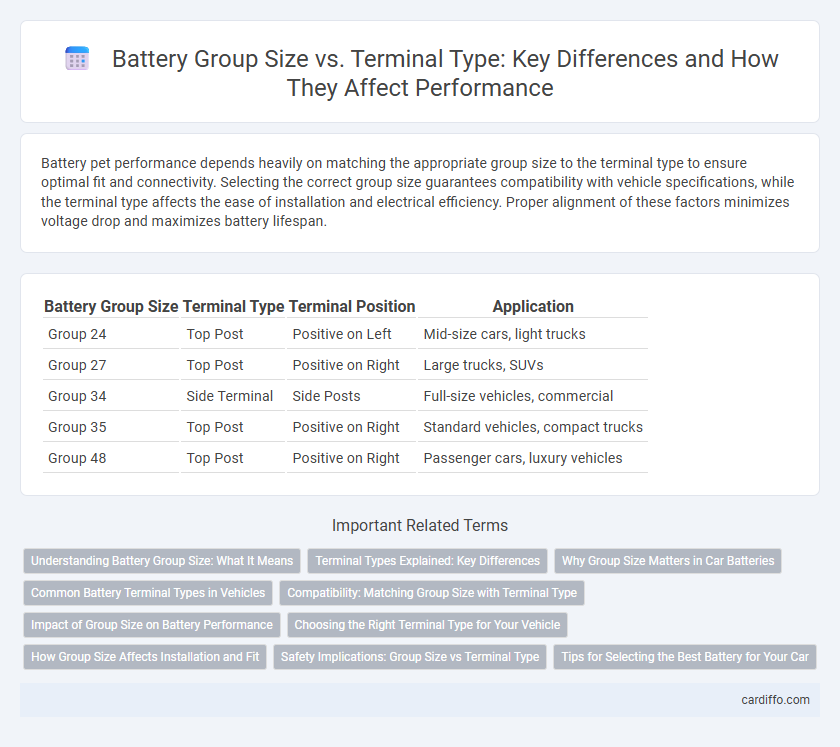Battery pet performance depends heavily on matching the appropriate group size to the terminal type to ensure optimal fit and connectivity. Selecting the correct group size guarantees compatibility with vehicle specifications, while the terminal type affects the ease of installation and electrical efficiency. Proper alignment of these factors minimizes voltage drop and maximizes battery lifespan.
Table of Comparison
| Battery Group Size | Terminal Type | Terminal Position | Application |
|---|---|---|---|
| Group 24 | Top Post | Positive on Left | Mid-size cars, light trucks |
| Group 27 | Top Post | Positive on Right | Large trucks, SUVs |
| Group 34 | Side Terminal | Side Posts | Full-size vehicles, commercial |
| Group 35 | Top Post | Positive on Right | Standard vehicles, compact trucks |
| Group 48 | Top Post | Positive on Right | Passenger cars, luxury vehicles |
Understanding Battery Group Size: What It Means
Battery group size defines the physical dimensions, terminal locations, and type, ensuring compatibility with vehicle specifications and battery trays. Terminal type, such as top post or side terminal, influences ease of installation and connection reliability, directly affecting electrical performance and safety. Selecting the correct group size and terminal type guarantees optimal fit, power delivery, and maintenance convenience.
Terminal Types Explained: Key Differences
Terminal types in batteries vary significantly based on group size, with common styles including top post, side terminal, and L-shaped terminals designed to fit specific vehicle or equipment requirements. Top post terminals provide easy access and strong connection for larger group sizes, while side terminals offer compact designs for applications with limited space, reducing corrosion risks. L-shaped terminals combine the benefits of secure mounting and ease of cable attachment, often preferred in heavy-duty or commercial battery groups for enhanced durability and maintenance efficiency.
Why Group Size Matters in Car Batteries
Group size in car batteries is crucial because it determines the battery's physical dimensions and terminal placement, ensuring a proper fit in the vehicle's battery tray. Incorrect group size can lead to terminal misalignment, which impacts cable connectivity and engine performance. Choosing the right group size prevents electrical issues and supports optimal power delivery for starting and running the vehicle efficiently.
Common Battery Terminal Types in Vehicles
Common battery terminal types in vehicles include top post, side post, and L-terminals, each designed to accommodate specific cable attachments and vehicle configurations. Top post terminals are widely used in most passenger cars due to their ease of access and secure connection, while side post terminals are often found in GM vehicles for a lower profile installation. L-terminals provide flexibility for custom or tight engine bays, allowing better cable management and improved fitment in certain automotive applications.
Compatibility: Matching Group Size with Terminal Type
Battery compatibility depends on matching the group size with the terminal type to ensure proper fit and secure connections. Group size specifies battery dimensions and terminal placement, which must align with the vehicle's terminal configuration to prevent installation issues. Incorrect pairing can lead to poor electrical contact, reduced performance, and potential safety hazards.
Impact of Group Size on Battery Performance
Larger battery group sizes typically provide higher capacity and longer runtime, enabling vehicles and devices to operate more efficiently over extended periods. The terminal type, such as SAE or JIS, affects connectivity and compatibility but has less influence on overall performance compared to group size. Selecting the appropriate group size ensures optimal energy delivery and longevity tailored to specific power demands and application requirements.
Choosing the Right Terminal Type for Your Vehicle
Selecting the appropriate terminal type is crucial for ensuring optimal battery performance and secure connections in your vehicle. Larger group sizes often require terminals with higher current capacity and corrosion-resistant materials to handle increased electrical demand. Matching the terminal type to your battery's group size prevents compatibility issues, improves conductivity, and extends battery life.
How Group Size Affects Installation and Fit
Group size directly influences the battery's physical dimensions, affecting installation and fit within the designated compartment of a vehicle or device. Larger group sizes require more space and may necessitate modifications or specific mounting solutions to ensure secure placement and optimal connectivity with terminal types. Selecting the correct group size ensures compatibility with terminal types and prevents issues such as poor contact, vibration damage, or electrical failures.
Safety Implications: Group Size vs Terminal Type
Battery group size directly impacts terminal type compatibility, which in turn affects safety during installation and operation. Larger group sizes often feature terminals that require more robust connections to handle higher current loads, reducing risks of loose connections or short circuits. Selecting the correct terminal type for the battery group size ensures optimal electrical contact and minimizes hazards such as overheating or acid leaks.
Tips for Selecting the Best Battery for Your Car
When selecting the best battery for your car, consider the group size that matches your vehicle's specifications to ensure a proper fit and optimal performance. Terminal type is equally important; choose between top-post or side-terminal batteries based on your car's battery tray and cable configuration for secure connections. Prioritize a battery with compatible group size and terminal type to prevent installation issues and avoid electrical problems.
Group Size vs Terminal Type Infographic

 cardiffo.com
cardiffo.com